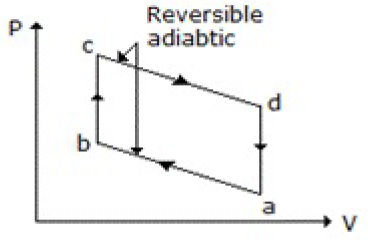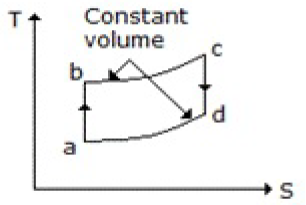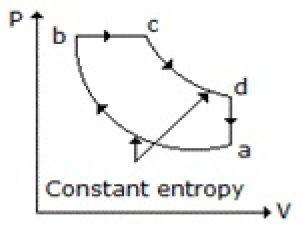Forward reaction will be favoured for the exothermic reaction, represented by CO + H2O CO2 + H2, by
Low temperature and high pressure
Low temperature and low pressure
High temperature and high pressure
High temperature and low pressure
Correct Answer :
A. Low temperature and high pressure
Related Questions
Isentropic process means a constant __________ process.
Enthalpy
Pressure
Entropy
None of these
Cv is given by
(∂E/∂T)V
(∂E/∂V)T
(∂E/∂P)V
(∂V/∂T)P
The equation, PV = nRT, is best obeyed by gases at
Low pressure & high temperature
High pressure & low temperature
Low pressure & low temperature
None of these
In a homogeneous solution, the activity coefficient of a component depends upon the
Pressure
Composition
Temperature
All (A), (B) and (C)
A gas has a volume of 27.3 c.c. at 0°C. Its volume at 10°C (if pressure remains unchanged) will be __________ c.c.
2.73
28.3
273
283
(∂E/∂T)V is the mathematical expression for
CV
Enthalpy change
Free energy change
None of these
(1/V) (∂V/∂T)P is the mathematical expression
Joule-Thomson co-efficient
Specific heat at constant pressure (Cp)
co-efficient of thermal expansion
Specific heat at constant volume (CV)
First law of thermodynamics deals with the
Direction of energy transfer
Reversible processes only
Irreversible processes only
None of these
High __________ is an undesirable property for a good refrigerant.
Specific heat
Latent heat of vaporisation
Viscosity
Specific vapor volume
Which of the following is affected by the temperature?
Fugacity
Activity co-efficient
Free energy
All (A), (B) & (C)
The root mean square speed of molecules of a gas is equal to (where, m = mass of the molecule K = Boltzmanns constant, T = absolute temperature)
√(2KT/m)
√(3KT/m)
√(6KT/m)
3KT/m
The heat capacities for the ideal gas state depend upon the
Pressure
Temperature
Both (A) & (B)
Neither (A) nor (B)
For an isothermal process, the internal energy of a gas
Increases
Decreases
Remains unchanged
Data insufficient, can't be predicted
In vapour compression refrigeration system, if the evaporator temperature and the condenser temperatures are -13°C and 37°C respectively, the Carnot COP will be
5.2
6.2
0.168
Data insufficient, can't be found out
Air-refrigeration cycle
Is the most efficient of all refrigeration cycles
Has very low efficiency
Requires relatively large quantities of air to achieve a significant amount of refrigeration
Both (B) and (C)
The equation, (d loge PA/d loge xA) = (d loge PA/d loge xB) applicable to a binary solution of components. A and B in equilibrium with their vapors at constant temperature and pressure is called the __________ equation.
Van Laar
Margules
Gibbs-Duhem
Gibbs-Duhem-Margules
The theoretical minimum work required to separate one mole of a liquid mixture at 1 atm, containing 50 mole % each of n- heptane and noctane into pure compounds each at 1 atm is
-2 RT ln 0.5
-RT ln 0.5
0.5 RT
2 RT
Which of the following processes cannot be made reversible even under ideal condition of operation?
Free expansion of a gas
Compression of air in a compressor
Expansion of steam in a turbine
All (A), (B) & (C)
Which of the following diagrams does not represent an Otto cycle?



None of these
Claude's liquefaction process employs the cooling of gases by
Expansion in an engine
Following a constant pressure cycle
Throttling
None of these
Filling of gas from a high pressure cylinder into small bottles is an example of a/an __________ process.
Equilibrium
Adiabatic
Steady
Unsteady
Maxwell's relation corresponding to the identity, dH = dS = Vdp + Σμi dni is
(∂T/∂V)S, ni = -(∂P/∂S)V, ni
(∂S/∂P)T, ni = (∂V/∂T)P, ni
(∂S/∂V)T, ni = (∂P/∂T)V, ni
(∂T/∂P)S, ni = (∂V/∂S)P, ni
The first law of thermodynamics is a restatement of the law of conservation of
Mass
Energy
Momentum
None of these
For an ideal liquid solution, which of the following is unity?
Activity
Fugacity
Activity co-efficient
Fugacity co-efficient
Ideal refrigeration cycle is
Same as Carnot cycle
Same as reverse Carnot cycle
Dependent on the refrigerant's properties
The least efficient of all refrigeration processes
The free energy change for a chemical reaction is given by (where, K = equilibrium constant)
RT ln K
-RT ln K
-R ln K
T ln K
Joule-Thomson co-efficient for a perfect gas is
Zero
Positive
Negative
None of these
For an ideal gas, the activity co-efficient is
Directly proportional to pressure
Inversely proportional to pressure
Unity at all pressures
None of these
The expression for entropy change given by, ΔS = nR ln (V2/V1) + nCv ln (T2/T1) is valid for
Reversible isothermal volume change
Heating of a substance
Cooling of a substance
Simultaneous heating and expansion of an ideal gas
Internal energy change of a system over one complete cycle in a cyclic process is
Zero
+ve
-ve
Dependent on the path
